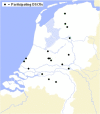Grip on challenging behavior: process evaluation of the implementation of a care program
- PMID: 25059544
- PMCID: PMC4132912
- DOI: 10.1186/1745-6215-15-302
Grip on challenging behavior: process evaluation of the implementation of a care program
Abstract
Background: The Grip on Challenging Behavior care program for managing challenging behavior was implemented in the dementia special care units of 17 Dutch nursing homes. A process evaluation of the implementation of the care program was performed to determine the quality of the implementation and the lessons to be learned for future implementation.
Methods: The care program was implemented according to a stepped wedge design. First-order data (data on recruitment, reach, relevance and feasibility) were used to determine the validity of the study, and second-order data (intervention quality and the barriers and facilitators for implementing the care program) were used to describe the implementation process. Two structured questionnaires were administered to care staff and key stakeholders and semi-structured interviews were held in the units.
Results: University affiliated and non-affiliated nursing homes from different parts of the Netherlands participated. The resident participation rate was over 95% and the participation rate for the training sessions was 82%. Respondents considered the care program relevant and feasible. The degree of implementation was not optimal. The barriers and facilitators in implementing the care program could be divided into three categories: organizational aspects, culture on the unit and aspects of the care program itself.
Conclusions: The recruitment, reach, relevance and feasibility are sufficient to allow for analysis and generalization of the effects of the care program, but the degree of implementation should be taken into account in further analysis. Future projects that involve implementation should consider the specific features of the organization and the cultural orientation of the unit to better adapt to specific needs.
Trial registration: The Netherlands National Trial register under number NTR2141 registered on 11 December 2009. Randomization took place in November 2010, and the first intervention group started using the intervention in February 2011.
Figures




Similar articles
-
Process Evaluation of an Intervention for the Management of Neuropsychiatric Symptoms in Young-Onset Dementia.J Am Med Dir Assoc. 2018 Aug;19(8):663-671. doi: 10.1016/j.jamda.2018.02.013. Epub 2018 Apr 10. J Am Med Dir Assoc. 2018. PMID: 29653809
-
Coming to grips with challenging behavior: a cluster randomized controlled trial on the effects of a multidisciplinary care program for challenging behavior in dementia.J Am Med Dir Assoc. 2014 Jul;15(7):531.e1-531.e10. doi: 10.1016/j.jamda.2014.04.007. Epub 2014 May 28. J Am Med Dir Assoc. 2014. PMID: 24878214 Clinical Trial.
-
Effects on staff outcomes and process evaluation of the educating nursing staff effectively (TENSE) program for managing challenging behavior in nursing home residents with dementia: A cluster-randomized controlled trial.Int J Nurs Stud. 2021 Aug;120:103982. doi: 10.1016/j.ijnurstu.2021.103982. Epub 2021 May 26. Int J Nurs Stud. 2021. PMID: 34171518 Clinical Trial.
-
Barriers and facilitators to implementing dementia care mapping in care homes: results from the DCM™ EPIC trial process evaluation.BMC Geriatr. 2019 Feb 8;19(1):37. doi: 10.1186/s12877-019-1045-y. BMC Geriatr. 2019. PMID: 30736748 Free PMC article. Clinical Trial.
-
[Dementia sensitivity in acute care hospitals : Why the implementation is so difficult, and how it can nevertheless succeed].Z Gerontol Geriatr. 2019 Nov;52(Suppl 4):291-296. doi: 10.1007/s00391-019-01631-2. Epub 2019 Oct 18. Z Gerontol Geriatr. 2019. PMID: 31628614 Review. German.
Cited by
-
Implementation of a tailored multifaceted antibiotic stewardship intervention to improve antibiotic prescribing for urinary tract infections in frail older adults (ImpresU) in four European countries: a process evaluation alongside a pragmatic cluster randomized controlled trial.Trials. 2024 Oct 18;25(1):691. doi: 10.1186/s13063-024-08545-4. Trials. 2024. PMID: 39425170 Free PMC article. Clinical Trial.
-
Improved participation of older people with joint contractures living in nursing homes: feasibility of study procedures in a cluster-randomised pilot trial.Trials. 2019 Jul 9;20(1):411. doi: 10.1186/s13063-019-3522-1. Trials. 2019. PMID: 31288846 Free PMC article. Clinical Trial.
-
Implementation of a Stepwise, Multidisciplinary Intervention for Pain and Challenging Behaviour in Dementia (STA OP!): A Process Evaluation.Int J Integr Care. 2018 Sep 7;18(3):15. doi: 10.5334/ijic.3973. Int J Integr Care. 2018. PMID: 30220897 Free PMC article.
-
Implementing a new living concept for persons with dementia in long-term care: evaluation of a quality improvement process.BMC Health Serv Res. 2024 Mar 7;24(1):306. doi: 10.1186/s12913-024-10765-y. BMC Health Serv Res. 2024. PMID: 38454437 Free PMC article.
-
Implementing a Personalized Integrated Stepped-Care Method (STIP-Method) to Prevent and Treat Neuropsychiatric Symptoms in Persons With Dementia in Nursing Homes: Protocol for a Mixed Methods Study.JMIR Res Protoc. 2022 Jun 22;11(6):e34550. doi: 10.2196/34550. JMIR Res Protoc. 2022. PMID: 35731558 Free PMC article.
References
-
- Dorland LM, Pot AM, Verbeek MA, Depla M. [Psychological assistance for older people in care homes and nursing homes; substudy 7] [in Dutch] Utrecht: Trimbos; 2007. pp. 37–43.
-
- Zwijsen SA, Smalbrugge M, Zuidema SU, Koopmans RT, Bosmans JE, van Tulder MW, Eefsting JA, Gerritsen DL, Pot AM. Grip on challenging behaviour: a multidisciplinary care programme for managing behavioural problems in nursing home residents with dementia. Study protocol. BMC Health Serv Res. 2011;11:41. doi: 10.1186/1472-6963-11-41. - DOI - PMC - PubMed
Publication types
MeSH terms
Associated data
LinkOut - more resources
Full Text Sources
Other Literature Sources
Medical

